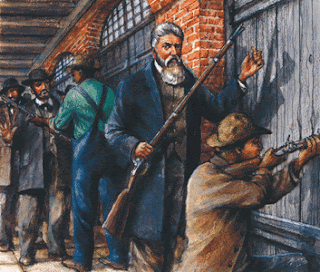The rest of Johann A Sutter's account of the discovery of gold can be found at the following linkl: http://www.sfmuseum.org/hist2/gold.html
Johann A. Sutter
(From the Virtual Museum of the City of San Francisco)
By December of 1848, the discovery of Gold gained national attention and President Polk confirmed the presence of gold before Congress. The discovery of gold created a frenzy and the local towns in Northern California initially became deserted as residents headed to the Sierras in the search for gold. As the news spread about the discovery of gold, people came from all over the world and the population of San Francisco and other nearby towns skyrocketed (Eye Wittness to History). Prior to the gold rush, California had a non-Indian population of 15,000 but by 1860 the non-Indian population of California shot up to 360,000 (Foner 2009). These newcomers to California included European and Australian immigrants, experienced miners from Mexico and South America as well as more than 25,000 Chinese. This influx of cultures from all over the world made San Francisco and it's surrounding towns the most ethnically diverse in the world. Most of these immigrants were men but some brave women followed their husbands in the search for gold. For some who could not strike it rich with gold, they found another opportunity for fortune by selling mining gear and equipment to those with gold fever. Selling mining equipment was an extremely lucrative business. One man by the name of Samuel Brannan, who was also a San Francisco Newspaper publisher who first wrote about the discovery of gold, made nearly 36,000 dollars in three months alone by selling anything and everything needed for gold mining (PBS American Experience, The Gold Rush).
This photo depicts a woman mining for gold alongside men
during the early gold rush, which was rare during this era.
(From the California State Library)
This photo depicts Chinese miners working alongside
Anglo miners at the Auburn Ravine in 1852.
(By J.B. Starkweather, retrieved from shmoop.com/california-gold-rush)
In 1852, the California State Legislature passed the foreign miners tax, under the persuasion of Anglo American miners. This law was designed to place a steep tax of 20 dollars per month on all foreign miners but was mainly imposed on Mexican, South American and Chinese miners. Within one year of the laws passage, an estimated three fourths of Mexican miners left California. The foreign miners that remained faced increasing discrimination and attacks from Anglo American miners (PBS American Experience, The Gold Rush).

Above is the Foreign Miners Tax which was first adopted in 1852.
This excerpt was taken from the 1861 California State Tax Laws.
(From: Local History Resources of Monterey County)
Despite the frenzy over gold and the dreams of becoming rich, most of the miners left with little more and sometimes even less than they came with. By 1851 the gold on California's surface was mostly gone and what was left required teams of specially equipped mining companies to dig out. The miners that remained were often hired by large mining companies for a weekly pay check. Even at this time there were still large sums of money to be made from gold, an estimated 60 million a year throughout the 1850's, but most of this money went into the hands of corporate investors. The real legacy of the gold rush is not about the money that was made, it is about the transformation of California. California went from a desolate town mainly populated by Native Americans to one that was booming with hundreds of thousands of ethnically diverse newcomers. New cities and towns sprung up all across California. New infrastructure was also being created including roads, schools, shops, churches and even the expansion of the First Transcontinental Railroad (PBS American Experience, The Gold Rush). The gold rush did not make many rich but it made the State of California rich and helped transform it into the prosperous state it came to be in the following decades.
References:
1. Foner, Eric (2009). Give Me Liberty!, An American History. Volume I, Second Seagull Edition
References:
1. Foner, Eric (2009). Give Me Liberty!, An American History. Volume I, Second Seagull Edition
2. PBS online. The American Experience, The Gold Rush. Retrieved from: http://www.pbs.org/wgbh/amex/goldrush/
3. Sutter, Johann A. (1857). The Discovery of Gold in California. Hutchings' California Magazine. Retrieved from The Virtual Museum of the City of San Francisco at: http://www.sfmuseum.org/hist2/gold.html
4. "The California Gold Rush, 1849". (2003). Eye Witness to History. Retrieved from: http://www.eyewitnesstohistory.com/californiagoldrush.htm
5. "The Foreign Miners Tax". Race, History and Demographics in Monterey
http://web.me.com/joelarkin/MontereyDemographicHistory/Foreign_Miners.html
6. "Gold Rush". The California State Library. Retrieved from: http://www.library.ca.gov/goldrush/
3. Sutter, Johann A. (1857). The Discovery of Gold in California. Hutchings' California Magazine. Retrieved from The Virtual Museum of the City of San Francisco at: http://www.sfmuseum.org/hist2/gold.html
4. "The California Gold Rush, 1849". (2003). Eye Witness to History. Retrieved from: http://www.eyewitnesstohistory.com/californiagoldrush.htm
5. "The Foreign Miners Tax". Race, History and Demographics in Monterey
http://web.me.com/joelarkin/MontereyDemographicHistory/Foreign_Miners.html
6. "Gold Rush". The California State Library. Retrieved from: http://www.library.ca.gov/goldrush/






